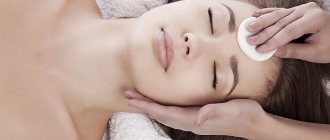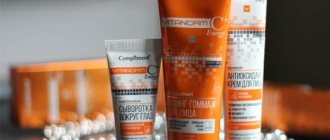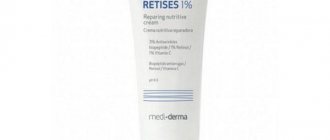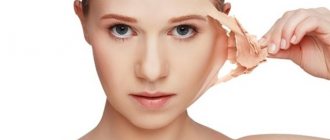Smooth, elastic skin and an even complexion are the main criteria for youth and beauty in any culture. Alas, not every person can boast of such natural wealth. And then it’s worth calling on modern cosmetology to help.
Today, one of the most effective and popular ways to cleanse and rejuvenate the skin is chemical peeling . “Rejuvenation without a scalpel” is what they say about this procedure, which helps get rid of a huge number of skin defects, including small superficial wrinkles.
The technique is aimed at eliminating imperfections in the skin of the face and body. As a result, the skin becomes smoother, its color is evened out, pigment spots, scars, stretch marks, post-acne become smaller or disappear altogether, and the function of the sebaceous glands is normalized. After the procedure, patients note an increase in skin tone and elasticity, smoothing of its relief, and the disappearance of small surface wrinkles. Reviews of chemical peeling, photos before and after the procedure posted on the Internet, speak in favor of this method.
Chemical peeling involves applying organic acids to the skin and dissolving the top layer of dead epidermal cells. Therefore, the procedure is also called acid peeling.
Of course, chemical peeling of the skin is a fairly radical method and can only be used by a knowledgeable and experienced dermatocosmetologist for serious indications.
1 ENERPEEL
2 Peel Tech Line
3 Inno Exfo Lightening
Mechanism of chemical peeling
Essentially, a chemical peel is a controlled burn of a specific area of the skin. Such an effect is necessary to restore the protective properties of the skin, forcing cells to renew and produce active substances. As a rule, the procedure is performed on the face (chemical peeling of the face), but it is also possible to treat other parts of the body - neck, hands, décolleté.
The degree of burn depends on the concentration of acid in the composition. After exfoliation (removal of the upper layers of the dermis), the cells begin to actively renew themselves and produce growth factors. The skin actively produces hyaluronic acid, and new elastin and collagen molecules are produced. This helps to moisturize and tighten the skin, increasing its elasticity.
Along with the improvement of skin tone, its texture is evened out and small surface wrinkles are smoothed out. The procedure also helps to get rid of other skin defects (hyperpigmentation, post-acne, scars).
Summarizing the above, we can say that chemical peeling helps:
- refresh and rejuvenate the face;
- remove age spots;
- cause activation of skin cells (due to anti-inflammatory effect);
- stimulate the active production of hyaluronic acid (i.e. achieve skin hydration);
- achieve restoration of density and elasticity of the epidermis;
- achieve rejuvenation of the structure of the dermis;
- restore the protective properties of the skin (restoration of the skin barrier).
1 Facial cleansing before peeling
2 Superficial chemical peeling procedure
3 Superficial chemical peeling procedure
Recovery (important nuances)
After chemical exfoliation, the patient will have a third-degree burn and a crust will appear, which should never be touched with hands, this can lead to infection, inflammation and pigmentation. This crust will peel off on its own in 10-15 days. It is mandatory to take antibiotics and anti-inflammatory drugs, but only as prescribed by the attending physician.
It is forbidden to be in the sun, sunbathing, or visiting baths and saunas. For the first three days, it is generally forbidden to even wash your face or brush your teeth - getting water on inflamed skin can be dangerous.
Results should not be expected immediately. Maximum effectiveness will be noticeable only after 2-3 months, not earlier.
Types of chemical skin peeling
Superficial peeling is the most gentle and safe way to refresh and rejuvenate the face, neck and décolleté. The impact is only on the thin stratum corneum of the epidermis (the outermost layer of the skin), so side effects from this procedure are practically eliminated (subject to all rules of post-peel care). When talking about superficial peeling, the expression “weekend peeling” is often used, since rehabilitation takes approximately the same period of time as a weekend.
The method helps improve the color and structure of the skin, is effective in combating acne and seborrhea, but does not guarantee getting rid of deep wrinkles, unevenness, and large age spots. Typically, patients under 40 years of age resort to this procedure to correct minor problems.
Depending on the condition and needs of the skin, lactic and fruit acids (AHA), salicylic acid, glycolic acid or 10-15% trichloroacetic acid are used for superficial peels. Instead of acids, enzymes can be used (enzyme peeling or enzymatic peeling). All these compositions, in addition to exfoliating dead cells, are designed to solve different problems (regulating hydrobalance, reducing pores, increasing tone, reducing inflammation, lightening, etc.), therefore, a cosmetologist can determine which active ingredient is preferable for the patient only after a face-to-face meeting .
Very popular in recent years, retinoic peeling or yellow peeling (active ingredients - retinol, retinoic acid) also belongs to superficial peelings in terms of the type of action on the skin, but is closer in effectiveness to medium peelings.
Retinoic peeling (retinol cleansing) is the choice, for example, when working with mature and/or pigmented skin, as well as skin prone to rashes.
Superficial peelings are usually carried out in courses of 4-6 procedures with a frequency of no more than once a week.
Medium peeling - its effect extends to the entire structure of the epidermis to the basement membrane. This is a very effective procedure, but the patient should be prepared for unpleasant sensations - with medium peeling, the concentration of acids is higher than with superficial manipulations, so the degree of skin damage is greater. The procedure involves further rehabilitation at home for about 7-10 days (due to severe redness and flaking of the skin).
Medium peels usually include trichloroacetic acid (or TCA) at a concentration of 30-40%, salicylic acid, and Jessner's solutions. By exfoliating dead skin cells of the epidermis, these components penetrate into the deep layers of the skin, causing the activity of living dermal cells. The procedure helps restore the protective properties of the skin, improve its turgor, increase density and elasticity. After medium peeling, manifestations of sagging skin go away, wrinkles straighten, scar elements, stretch marks, and age spots are smoothed out.
The procedure is carried out exclusively in the autumn-winter period, since renewed skin becomes especially susceptible to sunlight, and this threatens hyperpigmentation. The recommended course is from five sessions.
Deep peeling is the most impressive in action, but also the most traumatic. This is a serious chemical burn that damages the skin to the point of “blood dew.” This procedure is carried out under anesthesia and only in a hospital setting. The rehabilitation period after deep peeling can take months, but the effect will last for several years.
This procedure is also called phenol peeling because it is performed using phenol (carbolic acid). Under the influence of this substance, the entire stratum corneum of the skin is burned, and with it wrinkles, scars, signs of sagging and sagging skin. The density and elasticity of the epidermis is renewed and restored, and the structure of the dermis is rejuvenated.
Indications for such peeling may include age from 60 years or the presence of significant skin defects.
There is no need to talk about deep peeling as a course procedure because of its high traumatic and painful nature. A repeat is possible no earlier than in a few years.
Since chemical peeling is a radical method, the procedure must be carried out by a highly qualified dermatocosmetologist in a specially equipped medical office!
Indications for chemical peeling:
- biological aging;
- small superficial wrinkles;
- enlarged pores;
- freckles;
- dark spots;
- acne, post-acne;
- melasma;
- lentigo;
- stretch marks (stretch marks);
- sagging skin.
Contraindications to chemical peeling
- cancer;
- poor wound healing;
- tendency to form scars;
- pronounced rosacea;
- infectious diseases;
- dermatological diseases;
- chronic diseases in the acute stage;
- pregnancy and lactation;
- tan, very dark skin;
- recent invasive cosmetic procedures;
- taking certain medications.
1 Superficial chemical peeling procedure
2 Applying regenerating cream
3 Applying regenerating cream
The importance of preparation
A week before phenol peeling, you must start taking antiviral drugs (as prescribed by your doctor). In general, it is impossible to prepare the skin for a third-degree burn, and this is exactly what will be obtained as a result. The only thing that can be done is to saturate the skin with useful substances as much as possible and undergo a series of special procedures, but they must also be prescribed by a doctor.
Make arrangements in advance for a vacation, at least for a couple of weeks. After the procedure, the face looks unattractive and it is advisable to simply be in the comfort of your own home at this time.
Expert opinion
- Cosmetologist
- Surgeon
Irina Dorofeeva
practicing cosmetologist
Most peelings are prescribed in courses. But this does not apply to the deep effects of acids. Most cosmetologists advise undergoing such a procedure once in a lifetime. The fact is that such peeling affects the deep layers of the skin. You cannot do this manipulation yourself; it must be performed by a highly qualified specialist. An alternative to chemical peeling is, for example, a laser procedure.
Heather Pechey
plastic surgeon
Deep peeling is a complex procedure and can be compared to some extent with surgery.
I strongly recommend going only to reputable clinics. In addition, prepare for a long rehabilitation period, as you will get burned. This procedure is suitable for older women over 55 years of age. It is traumatic and painful. I would advise you to think 100 times whether deep peeling is worth it, or perhaps it is better to look for other rejuvenation options. Deep peeling is a serious cosmetic method of rejuvenation. After it is carried out, serious consequences await a person, for which it is worth preparing in advance. If you nevertheless decide to undergo this procedure, find a good specialist. Otherwise, you risk getting into trouble.
Price
The cost of such cleansing in each salon is individual; it also varies by city:
- Moscow from 3500;
- Rostov-on-Don from 3000;
- Tyumen from 2500.
On average, the cost of the procedure is about 3,000 thousand rubles, if you calculate the average price for Russian cities. The price of deep chemical peeling will depend on several parameters - the prestige of the clinic, the doctor’s experience, the city.
Some clinics and salons do not provide this procedure. The reason is the high toxicity of the active substance. If you are planning to undergo a session, then you should worry about looking for a suitable institution in advance.
Reviews
If you are planning to undergo deep facial peeling, reviews will help you finally decide whether to do it or not.
CATHERINE:
“I had a deep peeling done at a trusted salon. I was pleased with the result, although the rehabilitation was long and difficult.
Afterwards, my skin became young, tightened, and I began to look like I was 40 when I was almost 60. An incredible result! It’s a shame that you can’t use this service often, but I’ll definitely come back here in the future.”
ANNA:
“I went through the procedure and was dissatisfied - the doctor was young and inexperienced, but at first I didn’t attach any importance to it. Rehabilitation took 4 months, leaving scars that had to be removed with plastic surgery. Advice - carefully select a medical institution and a doctor in particular, and then you can avoid a negative experience.”
ELENA:
“I have hyperpigmentation and fine age wrinkles. After the procedure, all this became almost invisible. I won’t say that it disappeared completely, but the result is obvious. I was satisfied and recommend regular deep peeling after 60.”
CATHERINE:
“I have always suffered from an abundance of blackheads and acne scars. After completing the session, I was amazed - they disappeared, this simply does not happen. I’m 56 years old, but I look 45. The procedure is painful, the recovery is long, but it’s worth it, believe me! For a few thousand you can look at least 10 years younger, isn’t that what every woman dreams of?”
VASILISA:
“I ordered the service from a fashionable clinic, but was disappointed with the result. It is very painful, takes a long time to heal, and the result is almost invisible. Perhaps I chose the wrong clinic or doctor.”
Question answer
No, blepharoplasty can solve this problem. This is plastic surgery of the eyelids. The situation can be improved a little with the help of contour plastic surgery and microcurrent therapy.
The fact is that it is at this time that the sun’s activity decreases, and the worn-out skin after manipulation is highly vulnerable to UV rays. As a result, you may encounter problems, such as pigmentation. But even in winter it is worth using sunscreen.
It differs for each person and can take up to six months.










